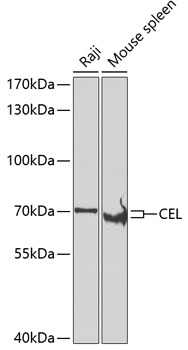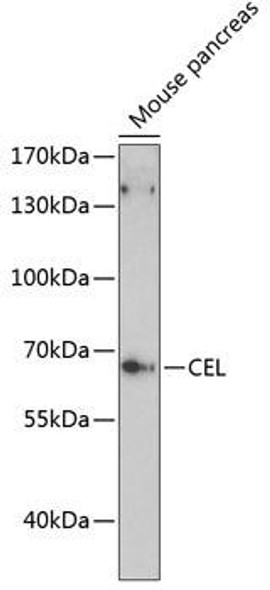Metabolism Antibodies 2
Anti-CEL Antibody (CAB7652)
- SKU:
- CAB7652
- Product Type:
- Antibody
- Reactivity:
- Human
- Reactivity:
- Mouse
- Reactivity:
- Rat
- Host Species:
- Rabbit
- Isotype:
- IgG
- Antibody Type:
- Polyclonal Antibody
- Research Area:
- Metabolism
Description
| Antibody Name: | Anti-CEL Antibody |
| Antibody SKU: | CAB7652 |
| Antibody Size: | 20uL, 50uL, 100uL |
| Application: | WB |
| Reactivity: | Human, Mouse, Rat |
| Host Species: | Rabbit |
| Immunogen: | A synthetic peptide of human CEL |
| Application: | WB |
| Recommended Dilution: | WB 1:500 - 1:2000 |
| Reactivity: | Human, Mouse, Rat |
| Positive Samples: | Raji, Mouse spleen |
| Immunogen: | A synthetic peptide of human CEL |
| Purification Method: | Affinity purification |
| Storage Buffer: | Store at -20'C. Avoid freeze / thaw cycles. Buffer: PBS with 0.02% sodium azide, 50% glycerol, pH7.3. |
| Isotype: | IgG |
| Sequence: | Email for sequence |
| Gene ID: | 1056 |
| Uniprot: | P19835 |
| Cellular Location: | Secreted |
| Calculated MW: | 71kDa/79kDa |
| Observed MW: | 71kDa |
| Synonyms: | CEL, BAL, BSDL, BSSL, CELL, CEase, FAP, FAPP, LIPA, MODY8 |
| Background: | The protein encoded by this gene is a glycoprotein secreted from the pancreas into the digestive tract and from the lactating mammary gland into human milk. The physiological role of this protein is in cholesterol and lipid-soluble vitamin ester hydrolysis and absorption. This encoded protein promotes large chylomicron production in the intestine. Also its presence in plasma suggests its interactions with cholesterol and oxidized lipoproteins to modulate the progression of atherosclerosis. In pancreatic tumoral cells, this encoded protein is thought to be sequestrated within the Golgi compartment and is probably not secreted. This gene contains a variable number of tandem repeat (VNTR) polymorphism in the coding region that may influence the function of the encoded protein. |
| UniProt Protein Function: | CEL: Catalyzes fat and vitamin absorption. Acts in concert with pancreatic lipase and colipase for the complete digestion of dietary triglycerides. Defects in CEL are a cause of maturity-onset diabetes of the young type 8 with exocrine dysfunction (MODY8); also known as diabetes and pancreatic exocrine dysfunction (DPED). MODY is a form of diabetes that is characterized by an autosomal dominant mode of inheritance, onset in childhood or early adulthood (usually before 25 years of age), a primary defect in insulin secretion and frequent insulin-independence at the beginning of the disease. Belongs to the type-B carboxylesterase/lipase family. 2 isoforms of the human protein are produced by alternative splicing. |
| UniProt Protein Details: | Protein type:Lipid Metabolism - glycerolipid; Lipid Metabolism - steroid biosynthesis; Secreted, signal peptide; EC 3.1.1.13; EC 3.1.1.3; Secreted; Lipase Chromosomal Location of Human Ortholog: 9q34.3 Cellular Component: extracellular space; cytoplasm; extracellular region Molecular Function:heparin binding; sterol esterase activity; triacylglycerol lipase activity; protein binding; hydrolase activity; acylglycerol lipase activity; catalytic activity Biological Process: intestinal lipid catabolic process; triacylglycerol metabolic process; cholesterol absorption; fatty acid catabolic process; lipid metabolic process; protein amino acid esterification; pancreatic juice secretion; cholesterol catabolic process; lipid digestion Disease: Maturity-onset Diabetes Of The Young, Type 8, With Exocrine Dysfunction |
| NCBI Summary: | The protein encoded by this gene is a glycoprotein secreted from the pancreas into the digestive tract and from the lactating mammary gland into human milk. The physiological role of this protein is in cholesterol and lipid-soluble vitamin ester hydrolysis and absorption. This encoded protein promotes large chylomicron production in the intestine. Also its presence in plasma suggests its interactions with cholesterol and oxidized lipoproteins to modulate the progression of atherosclerosis. In pancreatic tumoral cells, this encoded protein is thought to be sequestrated within the Golgi compartment and is probably not secreted. This gene contains a variable number of tandem repeat (VNTR) polymorphism in the coding region that may influence the function of the encoded protein. [provided by RefSeq, Jul 2008] |
| UniProt Code: | P19835 |
| NCBI GenInfo Identifier: | 251757481 |
| NCBI Gene ID: | 1056 |
| NCBI Accession: | P19835.3 |
| UniProt Secondary Accession: | P19835,Q16398, Q5T7U7, Q9UCH1, Q9UP41, |
| UniProt Related Accession: | P19835 |
| Molecular Weight: | 71,834 Da |
| NCBI Full Name: | Bile salt-activated lipase |
| NCBI Synonym Full Names: | carboxyl ester lipase |
| NCBI Official Symbol: | CEL |
| NCBI Official Synonym Symbols: | BAL; FAP; BSDL; BSSL; CELL; FAPP; LIPA; CEase; MODY8 |
| NCBI Protein Information: | bile salt-activated lipase; bile salt-dependent lipase, oncofetal isoform; bucelipase; carboxyl ester hydrolase; carboxyl ester lipase (bile salt-stimulated lipase); cholesterol esterase; fetoacinar pancreatic protein; lysophospholipase, pancreatic |
| UniProt Protein Name: | Bile salt-activated lipase |
| UniProt Synonym Protein Names: | Bile salt-stimulated lipase; BSSL; Bucelipase; Carboxyl ester lipase; Cholesterol esterase; Pancreatic lysophospholipase; Sterol esterase |
| Protein Family: | Bile salt-activated lipase |
| UniProt Gene Name: | CEL |
| UniProt Entry Name: | CEL_HUMAN |







